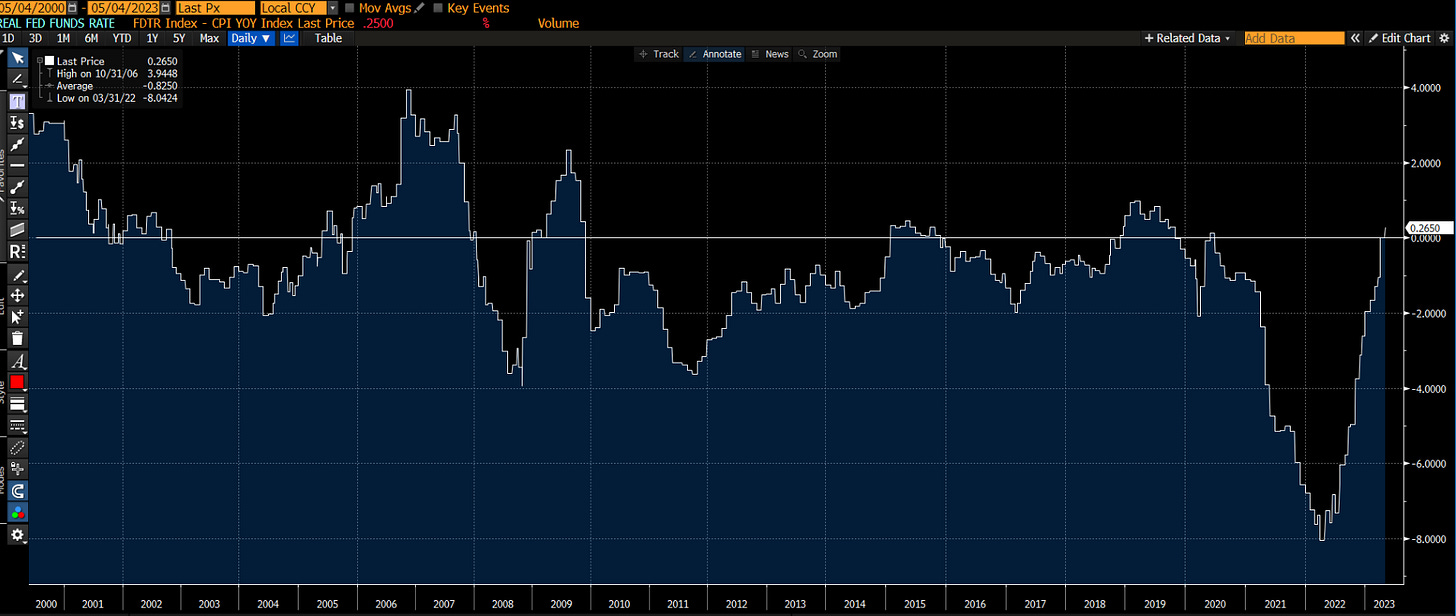Weekly Good Reads: 5-1-1
On Buffett’s portfolio, banks profitability diving, and U.S. real rates
Welcome to another issue of 5-1-1. Each week, I will include 3 links to relevant economic and investment news, 1 link to finance, and 1 to wellness pursuit based on what I read (5 links). I will also include 1 important chart and 1 investment term to know.

The week began with the swift sale of the First Republic Bank, the U.S. 14th largest bank, to JP Morgan, making the largest U.S. bank even larger. Regional banks’ price volatility overshadows the Fed Funds rate hike, which rose by another 25bp to a target rate of 5.25%, making the real Fed Funds rate a positive 0.26%, the first positive rate since the end of 2020.
The market is now concerned about the credit quality of the regional banks (due to some of them being heavily exposed to commercial real estate loans) in addition to securities losses on the bank’s books and the size of the uninsured deposits. The European Central Bank also slowed the interest rate hike to 25bp but no pause yet.
All eyes will be on how tight lending standards will be after the fall of the First Republic Bank. One thing is clear: the big banks are writing off bad debt and setting aside additional loan loss reserves as macroeconomic conditions worsen.
One area of optimism is in private credit - non-banks directly lending to corporates and real estate companies. As discussed at the Milken Institute Conference this week. private credit loans at a rate close to 8 to 10 % with better loan covenants have spurred interest in this asset class, as opposed to public and private equity.
With Treasury Secretary Janet Yellen warning the U.S. government is at risk of running out of cash by June 1 if an agreement on the debt limit is not struck, the U.S. yield curve (3-month minus 10-year rate) has pushed to the highest level (most inverted) in decades. The Chinese government’s creditworthiness, measured by the 1-year sovereign CDS rate at 30bp, is now better than that of the U.S., at 160bp. China is also striking more deals to increase the use of the Chinese Yuan with countries including Saudi Arabia, Russia, and France.
Next week's global data events include the U.S. April CPI, the U.K.’s GDP, the Bank of England interest rate decision, and credit and trade data from China.
Economy and Investments:
Buffett will beat the market as recession looms (Bloomberg)
Nobody knows anything, Fedwatch edition (Big Picture)
Profitability was the next shoe to drop for banks like PacWest (Bloomberg)
Finance/Wealth:
The 10 greatest US investors and the virtues that made them (CFA Institute) (Note, you would not have guessed the author’s first choice.)
Wellness:
Expanding our understanding of gut feelings (Harvard Gazette).
While the World Health Organization (WHO) declared on Friday that the COVID-19 global emergency is over, the global health threat is not - a good time to incorporate best health practices into our daily lives and public health policy after lessons learned through the Pandemic.
One Chart You Should Not Miss: U.S. Real Fed Funds Rate
Since the Great Financial Crisis in 2008, the real Fed Funds Rate (Fed Funds Rate minus the Consumer Price Index) has largely been negative. This reflects both a stimulative macro policy and some other structural factors of the economy at play, e.g., demographic changes and an increase in total factor productivity leading to a decline in the real Fed Funds rate over time.
As inflation is trending lower and credit crunches are getting more serious, thus slowing the economy, the Fed has reason to pause or cut rates, resulting in a lower real Fed Funds rate again (back to the long-term declining trend.)
One Term to Know: Regional Bank
Regional Banks, which in the U.S. have assets between $10 billion to $100 billion in assets, have been in the limelight since the collapse of the Silicon Valley Bank on March 10 this year.
Regional banks are smaller than national banks but bigger than community banks in terms of assets (e.g. loans, investments, cash). Regional banks serve an important function in serving the local community and smaller businesses. These banks offer more personalized services than national banks and more competitive rates. They also are involved in their communities, promoting wellness and financial literacy. They have a crucial economic role.
Please do not hesitate to get in touch if any questions!



